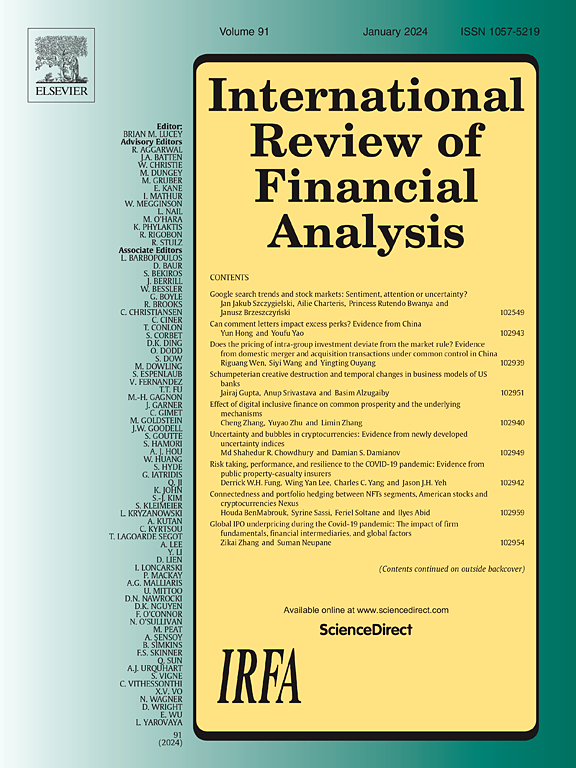通过企业生存评估企业ESG绩效:企业规模的调节作用
IF 9.8
1区 经济学
Q1 BUSINESS, FINANCE
引用次数: 0
摘要
本研究探讨了通过基于会计的模型(Altman Z-Score)和基于市场的模型(Merton Distance to Default)衡量的企业生存(CS)与通过Refinitiv ESG评级衡量的ESG绩效之间的关系。基于欧洲STOXX 600指数非金融公司的iqr归一化数据样本,该研究使用整体样本和区域分类方法(北欧、中欧和南欧)对2015年至2023年收集的数据进行了固定效应回归分析。最初的研究结果表明,Z-Score与ESG绩效之间总体上呈显著负相关,后者与Merton DD之间呈显著正相关。然而,在固定效应回归分析中,将总资产的自然对数作为企业规模的衡量标准,极大地改变了这些关系,导致两个模型总体上都呈现出显著的正相关。表明CS水平越高,ESG表现越好。此外,企业规模的调节效应使组合方法成为可能,因为两种CS措施能够被纳入同一回归模型。然而,即使这种情况适用于所有欧洲地区,南部地区的情况也显示出一些特殊性,抵消了北部和中部公司的结果。基于这些发现,我们进行了主成分分析(PCA),以探索这种影响如何成为更好地理解ESG绩效的有价值的工具。该方法提供的证据表明,如果控制了企业规模的调节作用,基于会计和基于市场的违约风险预测模型可以一起使用,以便更好地理解ESG绩效与CS之间的关系。本文章由计算机程序翻译,如有差异,请以英文原文为准。

Assessing Firm ESG Performance Through Corporate Survival: The Moderating Role of Firm Size
This study explores the relationship between Corporate Survival (CS), measured through both an accounting-based model (Altman Z-Score) and a market-based model (Merton Distance to Default), and ESG performance, measured through Refinitiv ESG ratings. Based on an IQR-normalized sample of data from non-financial companies listed on the STOXX 600 European index, the study conducted a fixed-effects regression analysis on data collected from 2015 to 2023, using both an overall sample and a regional classification methodology (Northern, Central, and Southern Europe). The initial findings indicated an overall negative and significant relationship between Z-Score and ESG performance, and a positive but non-significant relationship between the latter and Merton DD. However, incorporating the natural logarithm of total assets as a firm size measure within the fixed-effect regression analysis drastically changed these relationships, resulting in an overall positive and significant effect for both models, suggesting that higher CS levels involve superior ESG performance. Moreover, the moderating effect of firm size enabled a combined approach, as both CS measures were capable of being incorporated within the same regression model. However, even if this condition applies for all European regions, the Southern one showed some peculiarities that offsets the results obtained on both Northern and Central companies. Based on these findings, we conducted a Principal Component Analysis (PCA) to explore how this effect could serve as a valuable tool for better understanding ESG performance. This approach provided evidence that both accounting-based and market-based default risk prediction models can be used together for a better understanding of the relationship between ESG performance and CS if the moderating effect of firm size is controlled for.
求助全文
通过发布文献求助,成功后即可免费获取论文全文。
去求助
来源期刊

International Review of Financial Analysis
BUSINESS, FINANCE-
CiteScore
10.30
自引率
9.80%
发文量
366
期刊介绍:
The International Review of Financial Analysis (IRFA) is an impartial refereed journal designed to serve as a platform for high-quality financial research. It welcomes a diverse range of financial research topics and maintains an unbiased selection process. While not limited to U.S.-centric subjects, IRFA, as its title suggests, is open to valuable research contributions from around the world.
 求助内容:
求助内容: 应助结果提醒方式:
应助结果提醒方式:


